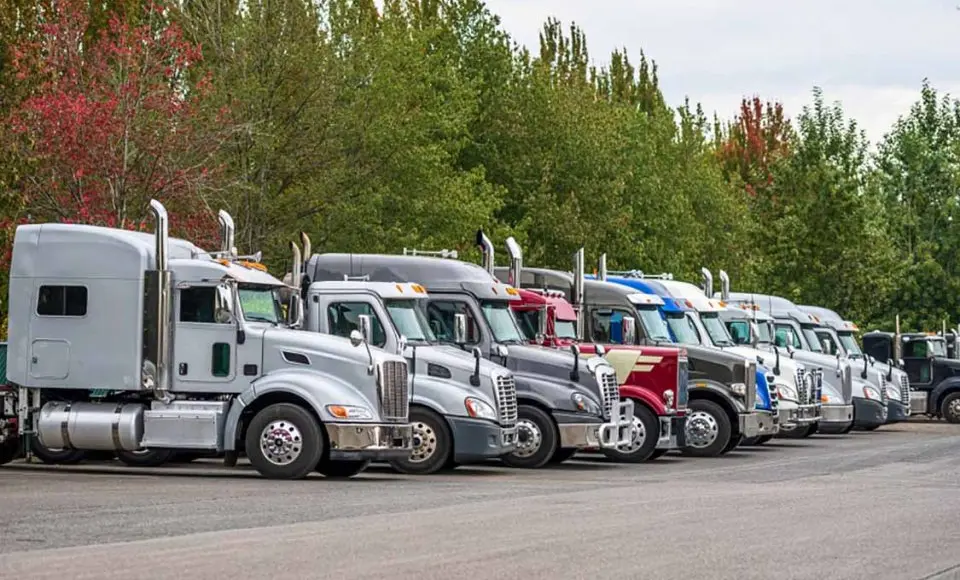Truckers can encounter various challenges when hauling cargo, and one of them is finding a suitable parking spot for their truck. Before pickup or after delivery, truckers often travel bobtail, which is the practice of driving a truck without a trailer.
Parking a semi-truck without a trailer is referred to as bobtail parking and represents a vital aspect of a truck driver’s daily routine – a practice that requires alertness, skill, strategy, and a keen understanding of the truck’s handling.
In this article, we will explore the practice of bobtail parking, discuss reasons why this should be considered, highlight best practices, and also share a step-by-step guide on how to park a bobtail truck.
What Is Bobtail Parking?
Bobtail parking refers to the process of parking a semi-tractor (also called a semi-truck) without a trailer. This practice is common in the industry, as truckers are often required to travel without any trailer attached to their truck.

For example, truck drivers often find themselves parking a semi-truck after dropping off a trailer at one location and before driving the truck to another location to pick up a different trailer.
Another common reason is when a driver is off-duty and looking for a place to temporarily park their truck. Driving bobtail poses safety risks, as the truck is subject to suboptimal weight distribution, reduced braking power, and altered handling, compared to trucks with trailers.
As a result, bobtail parking in designated areas like truck terminals, gas stations, truck stops, or similar locations, has become a common practice in the industry. Many truckers choose to park at these facilities to avoid returning to their home base without a trailer.
This more commonly occurs when making multiple deliveries within a few-mile radius. Alternatively, drivers could also park and wait at a client’s facility instead of driving back to their home base, incurring less cost (fuel, repairs, tickets, and more).
Reasons to Park Your Truck Bobtail
As explained earlier, there are several reasons why truckers choose to park their trucks bobtail. Below, we further explain some of these reasons in more detail.
Performing Drop-and-Hook
Truckers offering drop-and-hook services to shippers and receivers often wait for trailers to be ready for pickup after loading or unloading. Since the truck is now bobtail, the driver may choose not to drive back to base and wait somewhere nearby to minimize or prevent idling and bobtailing. They do this for different reasons, mainly to save travel time, reduce their cost per mile, and avoid unnecessary expenses.
Reached Maximum Hours of Service (HOS) Mid-Duty
Truck drivers are legally required to adhere to 14-hour Hours of Service (HOS) regulations. Therefore, in many cases, they may not have enough time to reach their home base after completing deliveries.
HOS violations can lead to severe penalties, especially if a driver operates the truck without any trailer due to increased safety hazards and accident risk. In light of this, some drivers opt for bobtail parking at suitable locations along their routes, such as truck stops and terminals, as well as rest areas.
Enhance Cargo Security
Not all locations or trucking routes are safe for drivers, especially those transporting high-value cargo across vast distances. Therefore, some carriers may instruct their drivers to uncouple loaded trailers in a more secure area and bobtail to a rest area or truck stop nearby to spend the night during layovers.
Freight that is unattended is more susceptible to theft and damage. Hence, parking trailers with cargo in secure facilities is a smart way to avoid security risks.
Awaiting Backhaul
Backhaul trucking is a common practice in the industry. Drivers often wait for backhaul loads for their return trips from a delivery location to increase revenue and minimize bobtailing and deadheading.
Sometimes, they are not able to secure backhaul loads on the same day of making a delivery. Therefore, they may opt for bobtail parking at different facilities and wait for a return load, instead of driving to home base.
How to Park Bobtail
Objectively speaking bobtail parking is simpler and more straightforward than parking a truck with an attached semi-trailer. However, it still requires a certain level of skill and experience, especially considering bobtail trucks handle differently.
Below, we’ve provided a step-by-step guide on how to park a bobtail truck. Make sure to follow this guide carefully and seek help or guidance from experienced truckers if required.
- Select a Suitable Parking Area:
Before parking a bobtail truck, proactively locate a suitable area, taking into account space, security, facilities, and other factors. Once a space is located, check for any obstacles or obstructions within or near the parking lot. - Check for Rules & Regulations:
Before approaching a parking area or trucking facility, verify that you are allowed to park bobtail. Some facilities may have restrictions based on local or state regulations or rules set by the operator. - Activate Your Turn Signals:
Use your turn signals to alert other drivers and pedestrians that you are about to park in a particular spot and keep it on until you’ve parked. Approach the spot slowly and steadily to ensure you don’t collide with any parked vehicles and other obstacles. - Position Your Truck:
Ensure that you have enough space on both sides of your truck while easing into the parking space. Periodically check your surroundings, especially if you’re looking to park between or alongside other trucks. You may have to use both forward and reverse gears to center your truck within the space. - Use Mirrors & Backup Camera (If Available):
Truck mirrors and backup cameras are powerful visual aids that can simplify bobtail parking. You can use them to gauge your position according to the parking space and lines. Don’t forget to use them to your advantage. - Reverse Slowly:
Reversing is often necessary when parking a truck. If you’re operating a manual truck, use the accelerator lightly. For automatic trucks, try not to use the accelerator to minimize your entry speed and maximize control. - Check Clearance:
Most inexperienced drivers rush parking and fail to check overhead and side clearances, leading to collisions with covered areas, low structures, and other parked trucks. To avoid this, step out of your bobtail truck and check your left, right, and back for tunnels, roofing, and barriers. - Secure Your Truck Vehicle:
Once your truck is aligned with the parking spot, put it in neutral and use the brake. For automatic trucks, simply put the gear in “Park (P)”. - Assess Parking:
Turn off your engine and exit the truck. Take a final look around to ensure you’ve parked properly within the designated space.
Where to Park Your Truck Bobtail
Bobtail parking is typically done in parking areas or locations designated for semi-trucks without trailers attached to them. Often these parking spots are also assigned to other commercial vehicles like box trucks, or busses.

Before parking at any facility, it’s best to ensure that the location allows bobtail parking. Below are some common examples of locations and parking areas that allow drivers to park bobtail:
- Truck Stops
- Truck Terminals
- Home Base
- Designated Parking Lots
- Rest Areas
- Distribution Centers
- Gas Stations
Best Practices When Parking Bobtail
Below, we list some of the best practices you can adopt to master bobtail parking at different facilities and locations.
- Ease into the Parking Spot – Bobtail parking requires precision, not speed. Hence, you should approach the parking spot slowly to maximize control. Take your time to align your semi-tractor within the space to avoid collisions and other issues.
- Practice Regularly – Regardless of your driving experience, regular practice is key to skill development. In other words, the more you practice bobtail parking, the easier it will become to judge clearances and angles over time, even in tight parking spaces.
- Look for a Secure Parking Area – Not every parking lot is the same when it comes to safety and security. There’s always a risk of theft, vandalism, assault, and other issues affecting productivity and performance. So, always do your due diligence when finding a location to park your bobtail truck.
- Familiarize Yourself with Your Truck – Finally, familiarize yourself with your truck’s dimensions, turning radius, handling changes, and maneuverability while bobtailing. Each make and model operates differently, in terms of handling, acceleration, and other aspects. By taking the time to know your vehicle, you can maximize control, increase parking efficiency, and minimize collision risks.

Get Free Course Access
If you enjoyed the article, don’t miss out on our free supply chain courses that help you stay ahead in your industry.

Andrew Lin
Co-Founder & Writer
at freightcourse
About the Author
Andrew is a multi-business owner with over 12 years of experience in the fields of logistics, trucking, manufacturing, operations, training, and education.
Being the co-founder of freightcourse has given him the ability to pursue his desire to educate others on manufacturing and supply chain topics.
Follow us